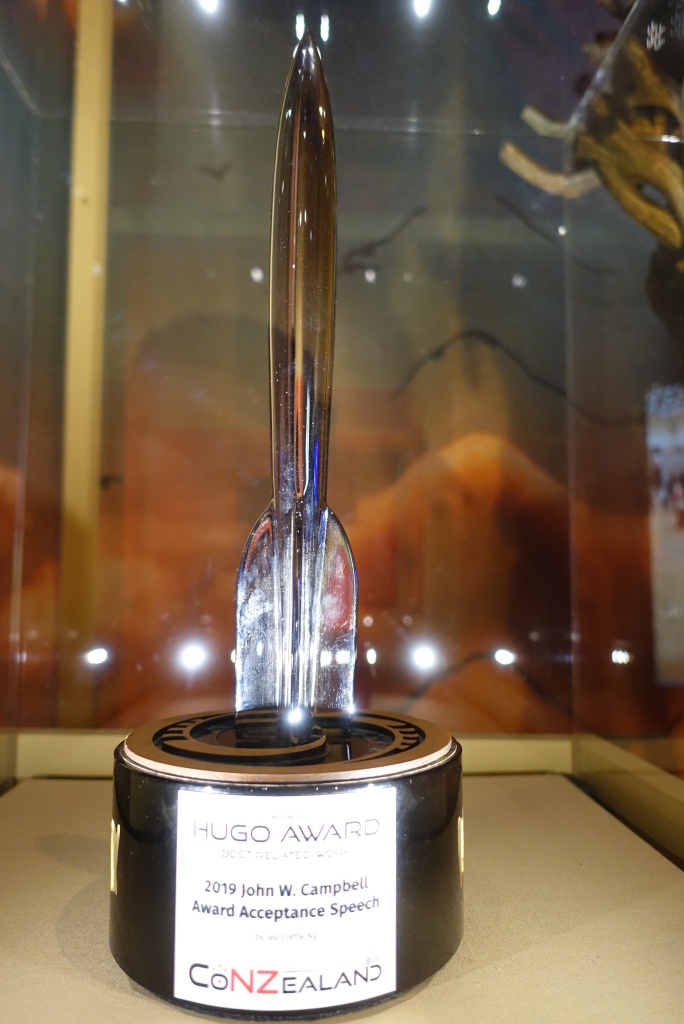Fantasy: Realms of ImaginationThe British Library Exhibition27th October 2023 – 25th February 2024
|
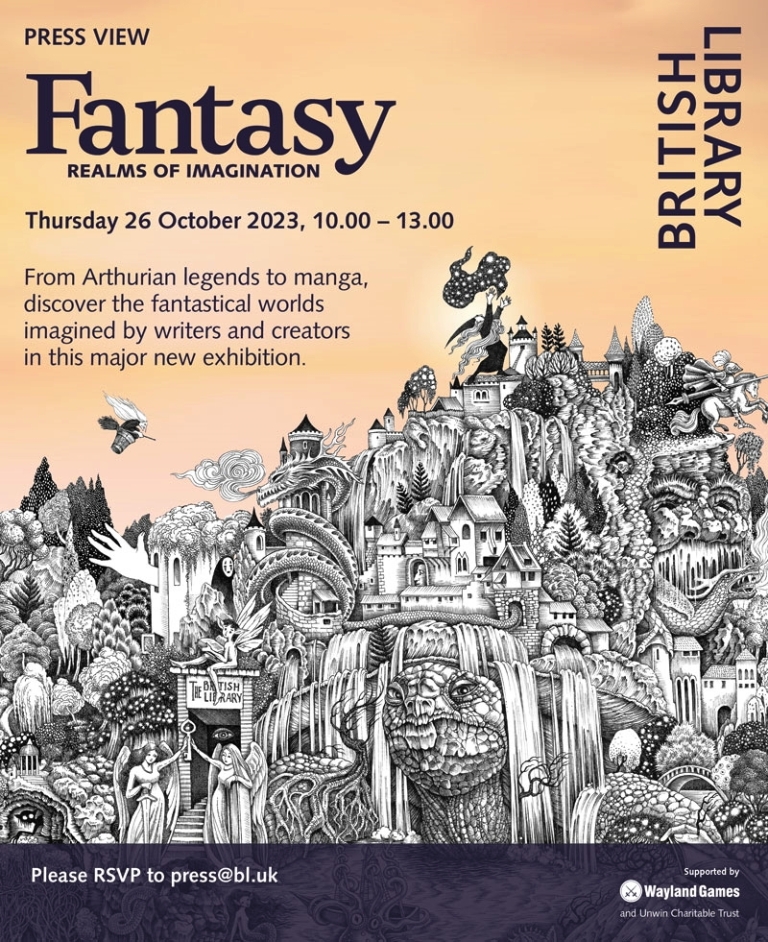 Press invite to the Exhibition launch. |
This new exhibition at the British Library explores the evolution of Fantasy. From ancient folk tales and fairy stories, gothic horror and weird fiction, to live action role-playing games inspired by Fantasy worlds, the exhibition celebrates the genre and its enduring impact…
First off, a word about the British Library. It is Britain's national library and also one of the six British Isles copyright depository centres: Britain has had legal deposit of all published works at least as since 1610. This means that every book published in the British Isles (including the Republic of Ireland) that has an ISBN (International Standard Book Number) or magazine & newspaper that has an ISSN (International Standard Serial Number), among others, are deposited with the British Library (though much is stored in a large store in York).

The British Library. (St Pancras station in the background.)
Yes, the main part of the building is meant to look like a ship
As such, the British Library is the UK's equivalent of the US's Library of Congress and the two rival each other in size. Truth be told, no-one knows which is bigger, what is known is that the British Library holds the second largest collection of pοrnography in the world: the largest, of course, is held by the Vatican (you knew that didn't you?). But there is more to it than that. The British Library also contains sound recordings, patents, academic journals, as well as a copy of every significant UK domain website and blog (including SF² Concatenation and Concatenation Science Communication on the Library's National Web Archive).
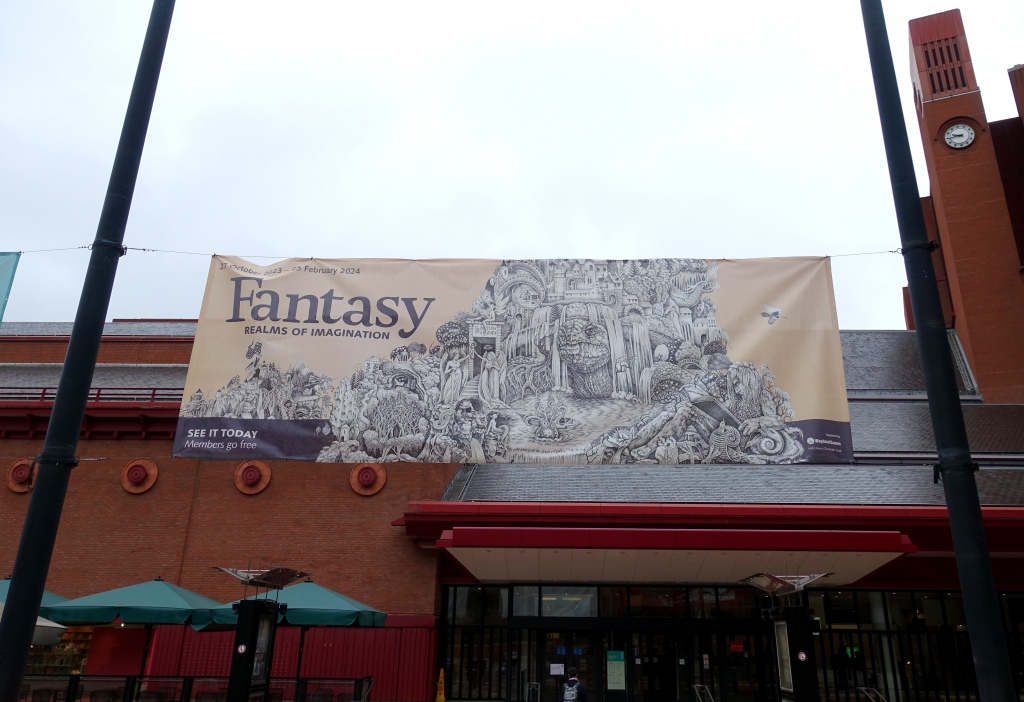
The exhibition itself contained over a hundred items – including historical manuscripts, rare first editions, drafts of iconic novels, scripts and maps, film props and costumes – that offer rare insights into the roots and evolution of the genre.
The afore term, 'rare', is used judiciously as many of the exhibits are decades old: some centuries old. And so the exhibits are held in a windowless, basement floor. This gives visitors the feeling that they are going through some sort of dungeons and dragons set, but actually, there is purposeful functionality behind this. With some exhibits many decades old, some even centuries, some display items need to be protected from too much light and all the glass cases have temperature and humidity monitors.
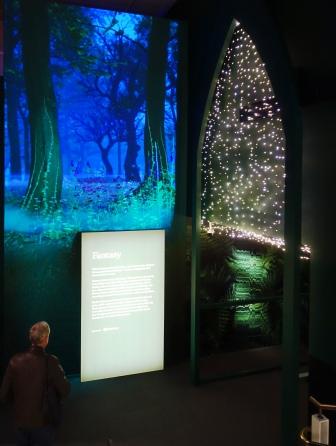 Gateway to the basement exhibition. 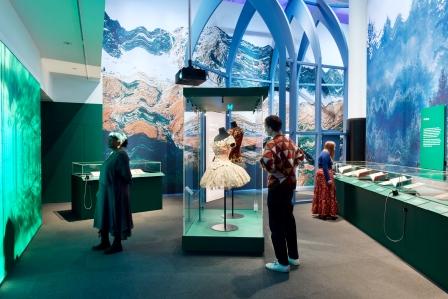 Most sections were well lit with colourful, wall backdrops. |
The displays themselves were arranged within fantastical sets, beginning with an illuminated forest scene (Mythago Wood anyone?) and decorative lighting along with a welcoming, illuminated, introductory text display.
Having said that, many of the exhibition sections were well lit with appropriate, colourful backdrops along the walls.
Of course being the British Library – with the emphasis on 'Library' – there were plenty of books on display, including: Beowulf, Sir Gawain and the Green Knight, C. S Lewis’ The Lion, The Witch and the Wardrobe, Lewis Carroll’s Alice’s Adventures Under Ground, The Magic City by E. Nesbit, The Owl Service by Alan Garner and The Colour of Magic by Terry Pratchett.
One of the more rare exhibits was a book of text fragments dating from the late 10th to early 11th century of Beowulf. This classic Old English epic poem is set against a time of war. The story itself centres around the hero Beowulf who battles the monster Grendel, Grendel's mother and a dragon. In his last fight, Beowulf, now an old man, over-reaches himself. In the fragment (see above), he kills the dragon but is himself mortally wounded.
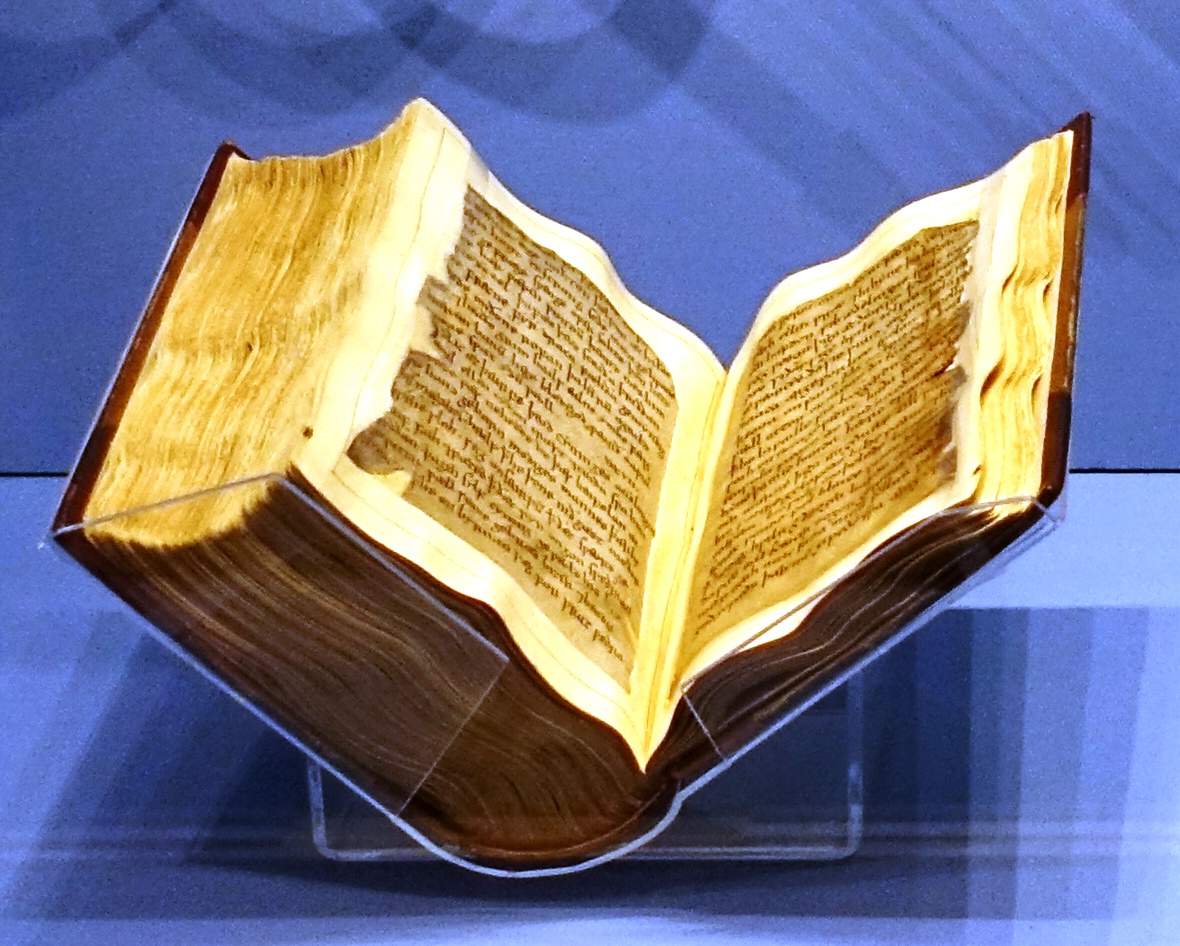
Fragments of the late 10th/early 11th century Old English Beowulf re-bound.
The exhibition drew together a number of themes (more of which later) and connections. Here, with Beowulf, a line was drawn from that Saxon epic to The Game of Thrones TV series and book, with the Beowulf fragments being displayed in the same cabinet as a 2019 Folio Society edition of A Game of Thrones and a licensed replica of the sword Needle as used by Arya Stark who, across the series, transformed from a carefree tomboy to skilled assassin. I'm guessing George R. R. Martin would approve?
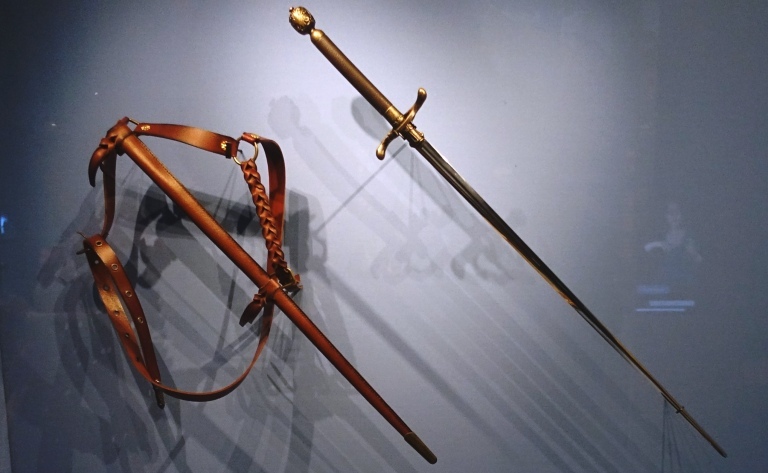
Game of Thrones (2011-'19) sword Needle.
But it was not all books; there were costumes from TV, film and even ballet as evidenced by a display of Margot Fonteyn's and Rudolf Nureyev's The Sleeping Beauty costumes (Princess Aurora and Prince Florimund respectively) from their 1968 production of Tchaikovsky's ballet. (This exhibit was kindly provided by the Royal Opera House, Covent Garden, London. See below.)
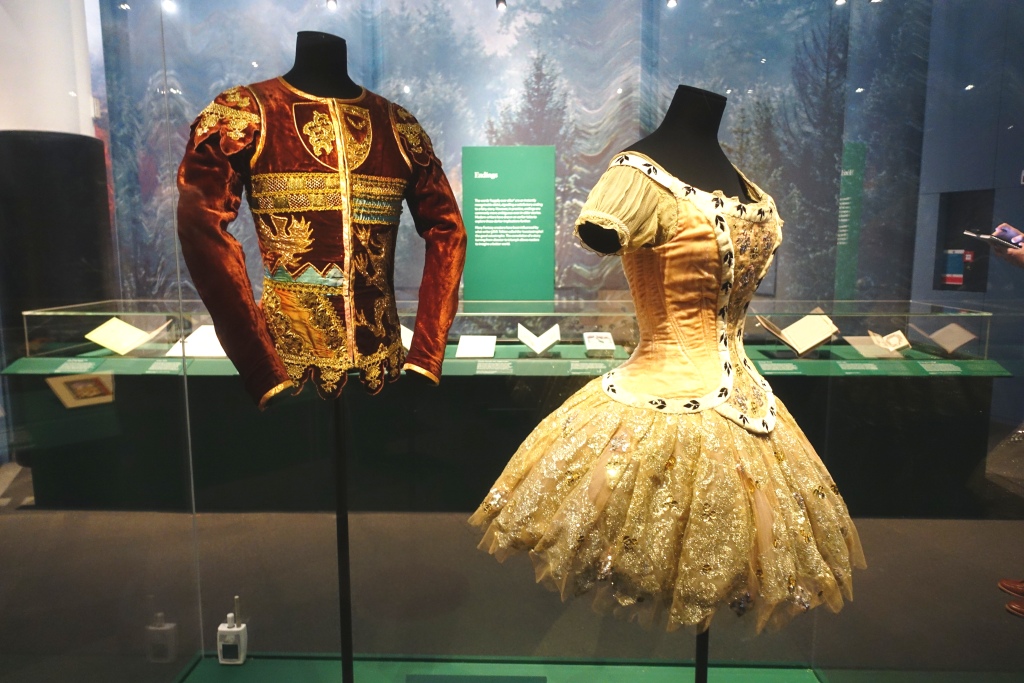
The Sleeping Beauty costumes from the 1968 Royal Ballet production.
Beyond themes and connections from exhibits displayed together as well as side-by-side, the exhibition was also divided into sections. Visitors begin entering a section called ‘Fairy and Folk Tales’ that takes us from The Snow Queen to The Arabian Nights and Peter Pan to discover how different cultures shape their own, iconic legends. Highlights included items from the Angela Carter archive and maps by Lewis for Narnia.
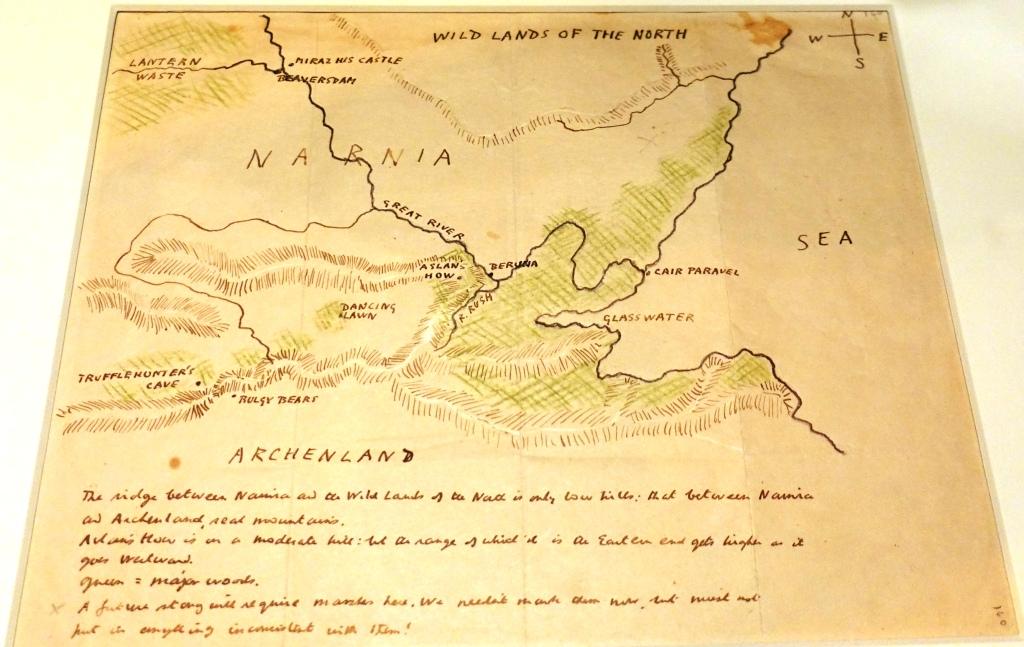
C. S. Lewis' map of Narnia.
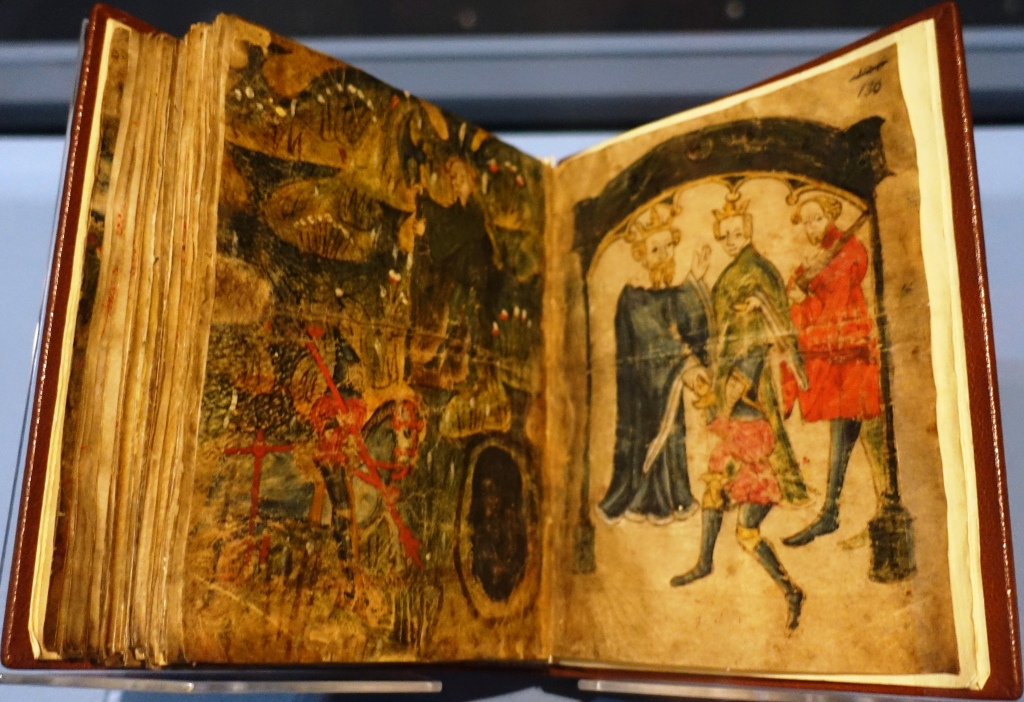
Sir Gawain and the Green Knight medieval edition.
From there it was straight into ‘Epics and Quests’, to meet heroes and villains from Sir Gawain and the Green Knight to Xena, Warrior Princess, and explore how ancient tales have helped to shape modern Fantasy epics. On display was a version of Gilgamesh, which some say is the oldest known epic story as it is thought to have originated from the Akkadian empire some 4,000 years ago! Gilgamesh being a semi-divine, Sumerian king who abuses his gifts of strength and bravery to abuse his people. The gods therefore create the wild man, Enkidu, to challenge the king. After a long struggle, the two become friends. When Enkidu is killed, Gilgamesh tries to solve the riddle of everlasting life…

Gilgamesh episode one, Gilgamesh and Enkiu
translated by Bill Griffiths and illustrated by Nicholas Parry (1992).
Of course fantasy comes into its own with the fantastical and the exhibition's next section was the ‘Weird and Uncanny’ that looked at fantasy's weird, otherworldly architectures and strangeness of uncanny places that can feel almost, but not quite, right to the utterly bizarre. An exemplar might be The City We Became that is based on the premise that a city can become alive and manifest as or in a person. But this manifestation is not without objection and not everyone wants the city to become manifest in such a way.
It was in this section that we encountered the novel 'Frankenstein'. Frankenstein I hear you cry! 'Surely that's Science Fiction, not Fantasy!' Well, clearly the curators were including Frankenstein within Fantasy. This was underlined by a short video interview with Ken Liu. He was of the opinion that SF sprang out of Fantasy and in that sense SF was a sub-genre of Fantasy. Now, there may be some mileage in this, though I am of the persuasion that Fantasy is distinct from Science Fiction though both come under the umbrella term Speculative Fiction. While there may be some merit in Ken Liu's argument, we should remember that Science Fiction arose with the Renaissance and its associated scientific revolution that led to the enlightenment. Without this new scientific perspective, we would not have Science Fiction. By comparison, it is true to say that humans are apes, but there is something about humans that make our species distinctly different from the other apes: other apes do not have the ability let alone potential to create the architecture, music, literature etc. that our species has. (Neither, to be fair, do they have the ability to despoil the planet and create a mass extinction). Humanity and human ecology, should be considered distinct from other animals and natural ecology. Science Fiction may have sprung from Fantasy but, I contend, it is sufficiently distinct from Fantasy that it should be considered a quite a distinct genre (even if some works can overlap as Science Fantasy). For this reason, if we are to have a new category of Hugo Award, then I'd opt for a 'Best Fantasy novel' category to allow more works of SF be short-listed in the 'Best Novel' category. But, hey, what do I know?
The thing is that this exhibition does not just fascinate and entertain but it also challenges visitors, even aged fans such as myself.
The Ken Liu interview was not the exhibitions only audiovisual material; there were excerpts from film, computer games and television. In the mix was an early scene from the Buffy The Vampire Slayer episode 'Hush'.
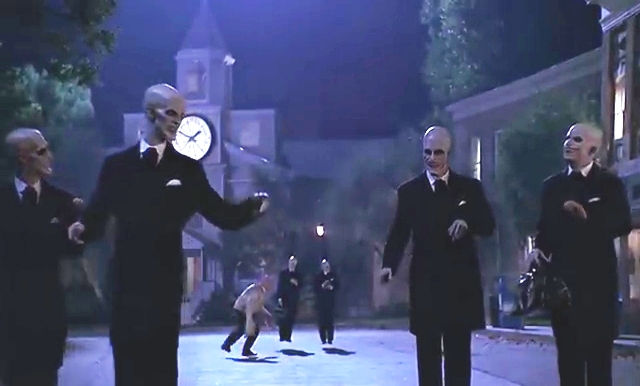
Buffy The Vampire Slayer episode 'Hush'.
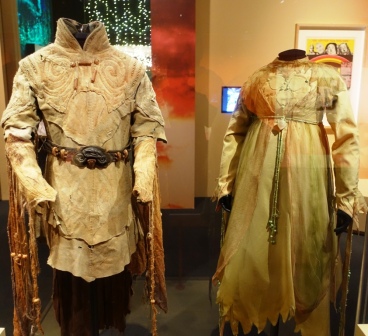 Gelfing costumes from The Dark Crystal |
The cinematic dimension was further explored in a number of places, including in part of the exhibition's ‘Portals and Worlds’ section. One of these was that of the world Thra portrayed in the film The Dark Crystal (1982) with Gelfing costumes designed by Brian Froud and concept artwork for the mystic urSkeks (sic) that were in turn brought to life by the puppeteer and the film's co-director, Jim Henson.
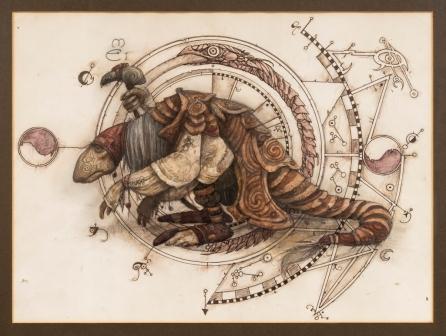
The Dark Crystal concept artwork for the mystic urAc (sic).
Another of the worlds was that of the Warhammer game with models on display.
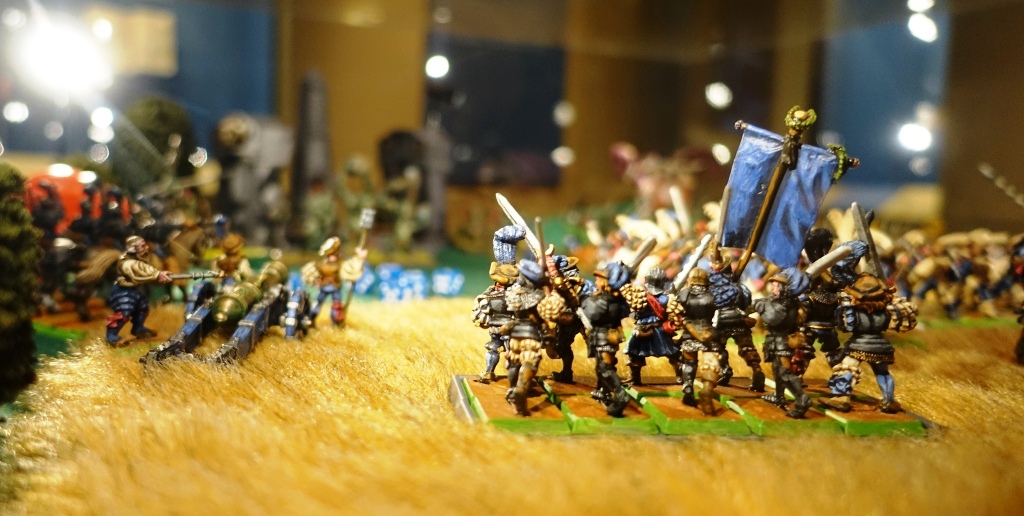
Warhammer figurines.
The final section looked at fandom. It included short video interviews of fans in cosplay as to why they liked fantasy and what it means to them, as well as an example of a fantasy cosplay costume. This section recognised the creativity and innovation that fans have brought to the genre and included a look at fan fiction.
Included is one of the Hugo Awards, the Hugo, of course, being the lead fan-voted SF award for 'Science Fiction achievement'. Specifically, the award on display was Jeannette Ng's in the 'Best Related Work' category given at the CoVID-struck, 2020 on-line New Zealand Worldcon. It was given for her acceptance speech the previous year's Worldcon in Dublin when she won the J. W. Campbell Award for Best New Writer (not to be confused with the juried John W. Campbell Memorial Award which is for the best SF work published the previous year in English). As the display explained, Jeannette used her speech to out John W. Campbell for his racism. Subsequently this caused Analog magazine – the Award's sponsors (Dell Magazines) – to change the Award's name to the Astounding Award after Astounding magazine which Campbell edited (that name-changed to the aforementioned Analog). As the exhibition implies, the 'fantasy' community does not just address make believe, but real issues of the day.
With over a hundred items on display it is only possible here to barely skim the surface of this remarkable exhibition. Dare I say it, it's even better than the Out Of This World Science Fiction exhibition the British Library put on with the help of the wonderful Science Fiction Foundation over a decade ago in 2011.
Much credit goes to the British Library's Tanya Kirk (the exhibition's lead curator) and her colleague Rachel Foss. They wisely sought out, and received guidance from a small advisory panel that included: Aliette de Bodard, Neil Gaiman, Roz Kaveney and Terri Windling. Susan Reed and Sophie Gosling also worked on the exhibition along with a guest curator from the University of Glasgow, Matthew Sangster. The exhibition was made possible with support from Wayland Games and The Unwin Charitable Trust (Allen & Unwin originally published Tolkien's The Hobbit), with thanks to The American Trust for the British Library and The B. H. Breslauer Fund of the American Trust for the British Library.
Tanya Kirk, Lead Curator of Fantasy: Realms of Imagination told SF² Concatenation how the exhibition was curated.
We started working on the exhibition back in 2019. The general scope of the exhibition and the four sections were established back then, the idea being that the exhibition would explore the history of the Fantasy genre from its roots in the oldest forms of storytelling right through to the present day. We decided on a thematic rather than a chronological approach as this allowed us to connect ancient items with new ones that drew inspiration from them.
We wanted to include as many different types of content as we could, to demonstrate the vibrancy of the genre today – so across over 100 objects, visitors can see books and manuscripts but also artworks, costume, props, clips from TV and film, games (including tabletop role- playing games, board games, card games and video games) and fan culture. We also interviewed writers and included clips of them talking about their works throughout the exhibition – including Victor LaValle, Terri Windling and Neil Gaiman – and interviewed Fantasy fans about what the genre means to them.
Four of the five curators working on the exhibition come from the British Library, but we also worked with an external curator, Professor Matthew Sangster from the Centre for Fantasy and the Fantastic at the University of Glasgow.
Tanya Kirk also revealed how Roz and Neil were involved:
We were really lucky to work with an amazing advisory board of Fantasy writers for the exhibition: Aliette de Bodard, Neil Gaiman, Roz Kaveney and Terri Windling. We met regularly with them over video calls during the planning phases of the exhibition, and they gave us brilliant advice on what were important things to include and how best to present particular themes. Neil and Terri were also interviewed for inclusion in the exhibition and both contributed to the exhibition’s accompanying book (Realms of Imagination: Essays from the Wide Worlds of Fantasy), and all four of the advisors feature in the amazing events programme that complements the exhibition.
The exhibition, which runs to 25th February 2024 at the British Library, is accompanied by a series of events including author panels. (Check out the British Library website for details.)
For the rest of the world, the really good news is that later the exhibition will be going on tour after it closes at the British Library, the first confirmed tour venue is the Bowers Museum, USA, from October 2024 to February 2025 with more to be announced.
Jonathan Cowie
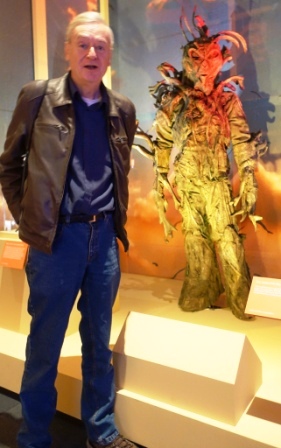 Above: With fan cosplay costume. Right: All that was left was the gift shop… |
Jonathan Cowie words. Tony Bailey pictures. Additional photographs (press invite & Sleeping Beauty hall) the British Library Press Office. 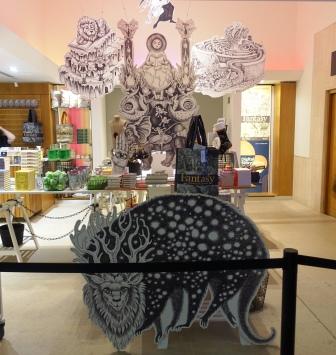 |
[Up: Article Index | Home Page: Science Fact & Fiction Concatenation | Recent Site Additions]
[Most recent Seasonal Science Fiction News]
[Convention Reviews Index | Top Science Fiction Films | Science Fiction Books]
[Science Fiction Non-Fiction & Popular Science Books]

